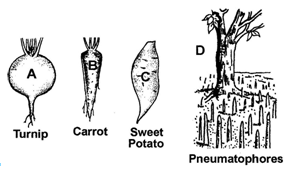The floral formula  represents
represents
(1) Solanum nigrum
(2) Hibiscus rosa-sinensis
(3) Citrus aurantum
(4) Brassica campestirs
Which of the following is incorrect about A, B, C and D:
(1) Tap roots of carrot, turnip and adventitious root of sweet potato, get swollen and store food
(2) Pneumatophores help to get oxygen for respiration
(3) Pneumatophore is found in the plants that grow in sandy soil
(4) A, B and C are underground roots but D grows vertically upwards
Offset is one internode-long runner and its each node bears rosette of leaves and a tuft of roots. It is found in aquatic plants like:
1. Hydrilla
2. Pistia
3. Eichhornia
4. Both (2) and (3)
Leafbase is swollen to form pulvinus in:
(1) Some leguminous plants
(2) Some crucifers
(3) Some monocots
(4) Some cycads
Which of the following statements is false about a leaf?
1. A leaf is said to be simple, when its lamina is entire or when incised, the incisions do not touch the margin
2. A leaf is said to be compound when the incisions of lamina reach up to the midrib breaking into several leaflets
3. Leaf is the most important vegetative organ for photosynthesis
4. Leaf is not a transpiratory organ
Leaves are modified into tendrils in:
(1) Parkinsonia
(2) Pea
(3) Ranunculus
(4) Oxalis
Cymose inflorescence is identified by:
1. Basipetal arrangement of flowers on the main axis (peduncle)
2. The limited growth of the main axis as main axis terminates in a flower
3. Both (1) and (2)
4. Presence of sessile flower
Which of the following is an incorrect match?
(1) Perigynous flower - Plum, rose and peach
(2) Monadelphous - Pea
(3) Epigynous flower - Guava, cucumber, and ray florets of sunflower
(4) Polyadelphous - Citrus
Match the Column-I with Column-II:
| Column-I (Aestivation in Corolla) |
Column-II (Examples) |
| A. Valvate | I. China rose, Lady’s finger, cotton |
| B. Twisted | II. Calotropis |
| C. Imbricate | III. Cassia, Gulmohur |
| D. Vexillary (papillonaceous) |
IV. Pea, Beans |
1. A - II, B - I, C - III, D - IV
2. A - II, B - I, C - IV, D - III
3. A - I, B - II, C - III, D - IV
4. A - II, B - IV, C - I, D - III
Identify the types of aestivation shown in the following diagram:
(1) A - Valvate, B - Twisted, C - Imbricate, D - Vexillary
(2) A - Vexillary, B - Valvate, C - Twisted, D - Imbricate
(3) A - Imbricate, B - Vexillary, C - Valvate, D - Twisted
(4) A - Twisted, B - Imbricate, C - Vexillary, D - Valvate



